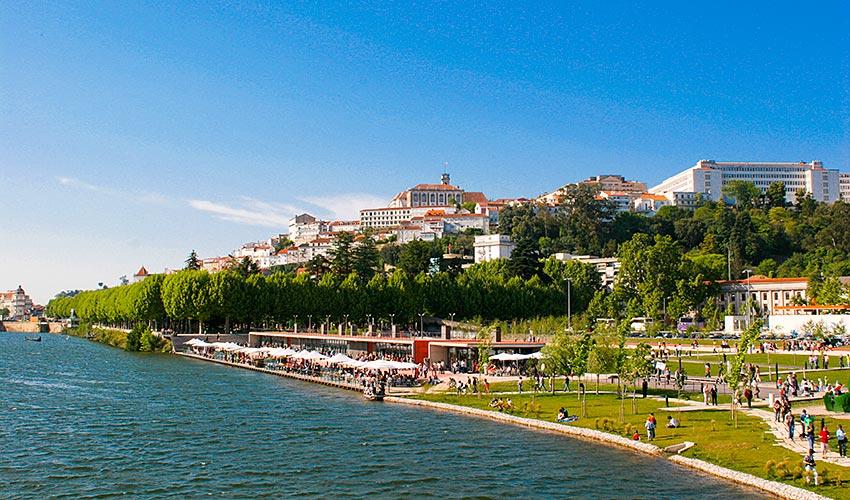Steeped in history and long regarded as Portugal’s cultural and intellectual centre, the district of Coimbra is a timeless destination that has inspired the works of acclaimed poets and writers, a long-standing tradition of soulful Fado serenades and a truly unique legacy of high-spirited academic rituals.
Coimbra is spread before the lovely Mondego river (the longest in the country) and is located between the central Portuguese districts of Aveiro and Viseu.
Chronicled as the most historic city in the region, the capital of Coimbra cradles some of the district’s most revered customs and monuments. After years of Roman occupation and Medieval rule, traces of Coimbra’s earliest days are scattered throughout the district and can be found in the historical port town of Figueira da Foz, Montemor-o-Velho’s imposing 9th Century castle and the ancient ruins of Conímbriga.
At the city’s highest point, you will find the prestigious University of Coimbra and its majestic 18th Century library, as well as the enchanting Botanic Garden. Also sharing this hilltop location is the 16th Century New Cathedral (Sé Nova) and the popular Machado de Castro art museum.
With its countless steps leading down to the historic centre, the Quebra Costas stairway (literally ‘the backbreaker’) has become a landmark in its own right. Here, you will find dynamic streets filled with typical restaurants and bars, shops of all sorts and many cafés. The Old Cathedral (Sé Velha), the City Hall and the Santa Cruz Church are some of the main attractions in the area and definitely worth a visit.
Every year, Coimbra attracts visitors with its vivacious academic celebrations, where enthusiastic crowds of students proudly parade their black cloaks throughout the city’s streets, chant cheerful folk songs and fill the air with the sound of guitars playing melodious Fado tunes. One of the most popular traditions is the Queima das Fitas, a graduation ceremony that takes place every May, when students burn ribbons to symbolise the end of their academic days.
Another attraction well worth visiting is the popular Portugal dos Pequenitos theme park, located on the south side of the river; a wonderful place where visitors of all ages can explore small-scale replicas of typical Portuguese villages, national monuments and buildings. Also be sure to see the intriguing ruins of the nearby Santa Clara-a-Velha Monastery.
Places to see
Religious Architecture
Igreja de Santa Cruz (Santa Cruz Church)
Once an important meeting place for the country’s intellectual elite, this former monastery has been designated a Panteão Nacional since 2003 and holds the tombs of Portugal’s first kings – D. Afonso Henriques and D. Sancho I. Although founded during the 12th Century, the structure was completely renovated four centuries later by King D. Manuel I, who changed the original architecture of the monastery to Manueline. The Renaissance ‘Manga Cloisters’ are a prime feature of the church and were given this name after sketched outlines of the cloisters were found on the sleeve (manga) of King João III’s doublet.
Mosteiro de Santa Clara-a-Velha (Santa Clara-a-Velha Monastery)
The fascinating ruins of this monastery are one of the earliest examples of Gothic architecture in the country. After the death of King D. Dinis in the 14th Century, Queen Elizabeth of Portugal (also known as the ‘Holy Queen’ or the ‘Peacemaker’) founded the monastery and dedicated the rest of her life to religion. Due to her profound devotion and generosity, the Queen was beatified after her death and became one of Portugal’s most esteemed saints. This monument also marks the place where Inês de Castro, the legendary ill-fated lady-in-waiting, would be murdered years later for pursuing her love affair with Prince Pedro, the soon-to-be king of Portugal.
Nature
Mata Nacional do Choupal (Choupal National Forest)
Named after its many poplar trees (choupos) this forest was planted during the 18th Century to stem the Mondego river. Today, visitors can enjoy its peaceful riverside atmosphere, admire beautiful trees, play sports or even go horseback riding.
Quinta das Lágrimas (Quinta das Lágrimas Gardens)
This romantic garden echoes the tragic love story between Inês de Castro and Prince Pedro – a legend that has inspired literature, poetry and song. Filled with ancient trees and fountains, a 19th Century palace and Neo-Gothic ruins, you will find yourself surrounded by true beauty. The famous ‘Fountain of Tears’, as well as the scarlet-coloured vegetation found within it, symbolically evoke the tears shed and the blood spilt by Inês de Castro when she was tragically executed in 1355 under the order of Prince Pedro’s father, King Afonso IV.
Historical Sites
Universidade de Coimbra (University of Coimbra)
Originally founded in Lisbon under the order of King D. Dinis, this esteemed university was transferred to Coimbra in 1537, where it still remains today. Apart from the grandiose architecture of the structure, the 18th Century Joanina Library is its greatest treasure and will dazzle you with its Baroque-inspired opulence, magnificent trompe d’oeil paintings and endless bookcases. Containing a total of 250,000 books, these age-old relics have been impeccably preserved with the help of a colony of bats who dwell in the library and feed on insects during the night.
Conímbriga
Conímbriga is one of Portugal’s largest excavated Roman sites and is a fantastic place to experience a glimpse of the past. Artefacts found during excavations prove that Coimbra was first inhabited between the 8– 9 Centuries BC, but only emerged as a prosperous society during Roman occupation towards the first half of the 2nd Century BC. City walls, mosaics, surprising examples of advanced water systems, thermal baths and buildings can all be admired. The Conímbriga Museum is one the most popular in the district and contains an interesting array of objects found during the site’s excavations.
Recommended Coimbra Hotels
Hotel Astoria Coimbra

 English
English  Português
Português  Deutsch
Deutsch 



